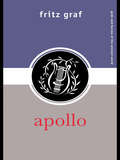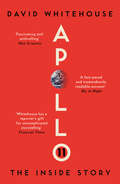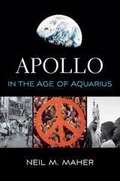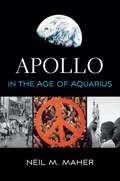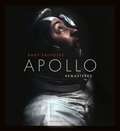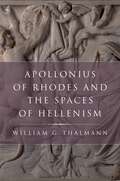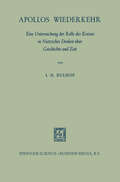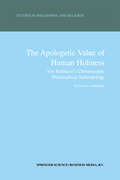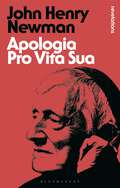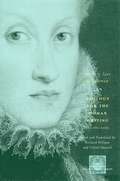- Table View
- List View
Apollo (Gods and Heroes of the Ancient World)
by Fritz GrafFritz Graf here presents a survey of a god once thought of as the most powerful of gods, and capable of great wrath should he be crossed: Apollo the sun god. From his first attestations in Homer, through the complex question of pre-Homeric Apollo, to the opposition between Apollo and Dionysos in nineteenth and twentieth-century thinking, Graf examines Greek religion and myth to provide a full account of Apollo in the ancient world. For students of Greek religion and culture, of myth and legend, and in the fields of art and literature, Apollo will provide an informative and enlightening introduction to this powerful figure from the past.
Apollo 11: The Inside Story
by David Whitehouse‘Terrific and enthralling’ New Scientist Fifty years ago, in July 1969, Apollo 11 became the first manned mission to land on the Moon, and Neil Armstrong the first man to step on to its surface. He and his crewmates, Buzz Aldrin and Michael Collins, were the latest men to risk their lives in this extraordinary scientific, engineering and human venture that would come to define the era. In Apollo 11: The Inside Story, David Whitehouse reveals the true drama behind the mission, putting it in the context of the wider space race and telling the story in the words of those who took part – based around exclusive interviews with the key players. This enthralling book takes us from the early rocket pioneers to the shock America received from the Soviets’ launch of the first satellite, Sputnik; from the race to put the first person into space to the iconic Apollo 11 landing and beyond, to the agonising drama of the Apollo 13 disaster and the eventual winding-up of the Apollo program. Here is the story as told by the crew of Apollo 11 and the many others who shared in their monumental endeavour. Astronauts, engineers, politicians, NASA officials, Soviet rivals – all tell their own story of a great moment of human achievement.
The Apollo Chronicles: Engineering America's First Moon Missions
by Brandon R. BrownThe moon landing of 1969 stands as an iconic moment for both the United States and humankind. The familiar story focuses on the journey of the brave astronauts, who brought home Moon rocks and startling photographs. But Apollo's full account includes the earthbound engineers, mounds of their crumpled paper, and smoldering metal shards of exploded engines. How exactly did the nation, step by difficult step, take men to the Moon and back? In The Apollo Chronicles, fifty years after the moon landing, author Brandon R. Brown, himself the son of an Apollo engineer, revisits the men and women who toiled behind the lights. He relays the defining twentieth-century project from its roots, bringing the engineers' work and personalities to bright life on the page. Set against the backdrop of a turbulent American decade, the narrative whisks audiences through tense deadlines and technical miracles, from President John F. Kennedy's 1961 challenge to NASA's 1969 lunar triumph, as engineers confronted wave after wave of previously unthinkable challenges. Brown immerses readers in key physical hurdles--from building the world's most powerful rockets to keeping humans alive in the hostile void of space--using language free of acronyms and technical jargon. The book also pulls back from the detailed tasks and asks larger questions. What did we learn about the Moon? And what can this uniquely innovative project teach us today?
The Apollo Chronicles: Engineering America's First Moon Missions
by Brandon R. BrownThe moon landing of 1969 stands as an iconic moment for both the United States and humankind. The familiar story focuses on the journey of the brave astronauts, who brought home Moon rocks and startling photographs. But Apollo's full account includes the earthbound engineers, mounds of their crumpled paper, and smoldering metal shards of exploded engines. How exactly did the nation, step by difficult step, take men to the Moon and back? In The Apollo Chronicles, fifty years after the moon landing, author Brandon R. Brown, himself the son of an Apollo engineer, revisits the men and women who toiled behind the lights. He relays the defining twentieth-century project from its roots, bringing the engineers' work and personalities to bright life on the page. Set against the backdrop of a turbulent American decade, the narrative whisks audiences through tense deadlines and technical miracles, from President John F. Kennedy's 1961 challenge to NASA's 1969 lunar triumph, as engineers confronted wave after wave of previously unthinkable challenges. Brown immerses readers in key physical hurdles--from building the world's most powerful rockets to keeping humans alive in the hostile void of space--using language free of acronyms and technical jargon. The book also pulls back from the detailed tasks and asks larger questions. What did we learn about the Moon? And what can this uniquely innovative project teach us today?
Apollo in the Age of Aquarius
by Neil M. MaherIn summer 1969, astronauts landed on the moon and hippie hordes descended on Woodstock—two era-defining events that are not entirely coincidental. Neil M. Maher shows how NASA’s celestial aspirations were tethered to terrestrial concerns of the time: the civil rights struggle, the antiwar movement, environmentalism, feminism, and the culture wars.
Apollo in the Age of Aquarius
by Neil M. MaherIn summer 1969, astronauts landed on the moon and hippie hordes descended on Woodstock—two era-defining events that are not entirely coincidental. Neil M. Maher shows how NASA’s celestial aspirations were tethered to terrestrial concerns of the time: the civil rights struggle, the antiwar movement, environmentalism, feminism, and the culture wars.
Apollo Mission Control: The Making of a National Historic Landmark (Springer Praxis Books)
by Manfred "Dutch" von EhrenfriedThis book describes the history of this now iconic room which represents America’s space program during the Gemini, Apollo, Skylab, Apollo-Soyuz and early Space Shuttle eras. It is now a National Historic Landmark and is being restored to a level which represents the day the flight control teams walked out after the last lunar landing missions. The book is dedicated to the estimated 3,000 men and women who supported the flights and tells the story from their perspective. It describes the rooms of people supporting this control center; those rooms of engineers, analysts and scientists most people never knew about. Some called it a “shrine” and some called it a “cathedral.” Now it will be restored to its former glory and soon thousands will be able to view the place where America flew to the moon.
The Apollo Missions: The Incredible Story of the Race to the Moon
by Dr David BakerLong has the moon captured the imagination of world; from science fiction to astrology; howling wolves to lunar calendars. To President John F. Kennedy, however, the moon was a destination. To put a man on the moon would be to challenge Russia's recent achievements in space exploration and assert the US's technological prowess on the world stage. As we know, the mission was a success, and yet while everyone is familiar with Neil Armstrong's iconic line and his bold tread on the moon's dusty surface, few are privy to the events leading up to this moment. Former NASA engineer, David Baker, gives a behind-the-scenes account of the space race, including the political impetus behind the mission, the Apollo 8's lunar orbit on Christmas Eve, as well as some of the tale's tragedies. Bursting with fascinating stories, striking photographs of the team and exclusive material provided by NASA personnel, this book perfectly captures the risk, complexity and gravitas of this immense journey.
Apollo Remastered: The Sunday Times Bestseller
by Andy SaundersDiscover space as you've never seen it before, with these awe-inspiring, breathtakingly restored images of our first missions to the Moon'The next best thing to being there' Charlie Duke, Apollo 16 astronautIn a frozen vault in Houston sits the original NASA photographic film of the Apollo missions. For half a century, almost every image of the Moon landings publicly available was produced from a lower-quality copy of these originals.Now we can view them as never before. Expert image restorer Andy Saunders has taken newly available digital scans and, applying pain-staking care and cutting-edge enhancement techniques, he has created the highest quality Apollo photographs ever produced. Never-before-seen spacewalks and crystal-clear portraits of astronauts in their spacecraft, along with startling new visions of the Earth and the Moon, offer astounding new insight into one of our greatest endeavours. This is the definitive record of the Apollo missions and a mesmerizing, high definition journey into the unknown.
Apollonius of Rhodes and the Spaces of Hellenism (Classical Culture and Society)
by William G. ThalmannAlthough Apollonius of Rhodes' extraordinary epic poem on the Argonauts' quest for the Golden Fleece has begun to get the attention it deserves, it still is not well known to many readers and scholars. This book explores the poem's relation to the conditions of its writing in third century BCE Alexandria, where a multicultural environment transformed the Greeks' understanding of themselves and the world. Apollonius uses the resources of the imagination - the myth of the Argonauts' voyage and their encounters with other peoples - to probe the expanded possibilities and the anxieties opened up when definitions of Hellenism and boundaries between Greeks and others were exposed to question. Central to this concern with definitions is the poem's representation of space. Thalmann uses spatial theories from cultural geography and anthropology to argue that the Argo's itinerary defines space from a Greek perspective that is at the same time qualified. Its limits are exposed, and the signs with which the Argonauts mark space by their passage preserve the stories of their complex interactions with non-Greeks. The book closely considers many episodes in the narrative with regard to the Argonauts' redefinition of space and the implications of their actions for the Greeks' situation in Egypt, and it ends by considering Alexandria itself as a space that accommodated both Greek and Egyptian cultures.
Apollo's Eye: A Cartographic Genealogy of the Earth in the Western Imagination
by Carmen P. Cosgrove"Earthbound humans are unable to embrace more than a tiny part of the planetary surface. But in their imagination they can grasp the whole of the earth, as a surface or a solid body, to locate it within infinities of space and to communicate and share images of it."—from the Preface Long before we had the ability to photograph the earth from space—to see our planet as it would be seen by the Greek god Apollo—images of the earth as a globe had captured popular imagination. In Apollo's Eye, geographer Denis Cosgrove examines the historical implications for the West of conceiving and representing the earth as a globe: a unified, spherical body. Cosgrove traces how ideas of globalism and globalization have shifted historically in relation to changing images of the earth, from antiquity to the Space Age. He connects the evolving image of a unified globe to politically powerful conceptions of human unity.
Apollos Wiederkehr: Eine Untersuchung der Rolle des Kreises in Nietzsches Denken über Geschichte und Zeit
by Ilse Nina BulhofApollos Wiederkehr: Eine Untersuchung der Rolle des Kreises in Nietzsches Denken über Geschichte und Zeit
by Ilse-Nina Bulhof-RutgersThe Apologetic Value of Human Holiness: Von Balthasar’s Christocentric Philosophical Anthropology (Studies in Philosophy and Religion #21)
by Victoria S. HarrisonThe Apologetic Value of Human Holiness begins by providing the first comprehensive account of the model of human holiness developed by the leading theologian Hans Urs von Balthasar. In so doing, the book also provides the first detailed explication of his Christocentric philosophical anthropology. Part 2 argues that von Balthasar anticipates some key developments in late twentieth-century Anglo-American analytical philosophy, and that certain of these developments - in particular, the `internal realism' of Hilary Putnam - provide powerful support for von Balthasar's theological philosophy. The final part elucidates von Balthasar's core intuition that human holiness is of immense apologetic value for religious faith, and concludes with a new, `internalist' theory of religious pluralism. The Apologetic Value of Human Holiness will be seen as an important and original contribution to both Philosophy of Religion and Theology, and is likely to prove essential reading in upper-level undergraduate and postgraduate courses in both subjects.
Apologia Pro Vita Sua (Bloomsbury Revelations)
by John Henry NewmanEven before the publication of his masterwork, John Henry Newman had been regarded as one of the most important religious thinkers on the 19th Century. His decision in 1845 to leave his Anglicanism behind and convert to the Roman Catholic faith was one that rocked the Victorian establishment at a time when virulent anti-Catholic feeling ran high. It was in response to one particularly vicious attack – by the Reverend Charles Kingsley – that Newman wrote his Apologia Pro Vita Sua. A humane and vivid account of the development of his ideas and his faith and a passionate defence of both, the book remains a landmark work of Victorian literature and autobiography and one that continues to resonate to this day.
Apologia Pro Vita Sua (Bloomsbury Revelations)
by John Henry NewmanEven before the publication of his masterwork, John Henry Newman had been regarded as one of the most important religious thinkers on the 19th Century. His decision in 1845 to leave his Anglicanism behind and convert to the Roman Catholic faith was one that rocked the Victorian establishment at a time when virulent anti-Catholic feeling ran high. It was in response to one particularly vicious attack – by the Reverend Charles Kingsley – that Newman wrote his Apologia Pro Vita Sua. A humane and vivid account of the development of his ideas and his faith and a passionate defence of both, the book remains a landmark work of Victorian literature and autobiography and one that continues to resonate to this day.
Apologies and the Legacy of Abuse of Children in 'Care': International Perspectives (Palgrave Studies in the History of Childhood)
by Johanna Sk�ld Shurlee SwainThis book positions inquiries into the historical abuse of children in care within the context of transitional justice. It examines investigation, apology and redress processes across a range of Western nations to trace the growth of the movement, national particularities and the impact of the work on professionals involved.
Apologies to Thucydides: Understanding History as Culture and Vice Versa
by Marshall SahlinsThucydides' classic work on the history of the Peloponnesian War is the root of Western conceptions of history—including the idea that Western history is the foundation of everyone else's. Here, Marshall Sahlins takes on Thucydides and the conceptions of history he wrought with a groundbreaking new book that shows what a difference an anthropological concept of culture can make to the writing of history. Sahlins begins by confronting Thucydides' account of the Peloponnesian War with an analogous "Polynesian War," the fight for the domination of the Fiji Islands (1843-55) between a great sea power (like Athens) and a great land power (like Sparta). Sahlins draws parallels between the conflicts with an eye to their respective systems of power and sovereignty as well as to Thucydides' alternation between individual (Pericles, Themistocles) and collective (the Athenians, the Spartans) actors in the making of history. Characteristic of most histories ever written, this alternation between the agency of "Great Men" and collective entities leads Sahlins to a series of incisive analyses ranging in subject matter from Bobby Thomson's "shot heard round the world" for the 1951 Giants to the history-making of Napoleon and certain divine kings to the brouhaha over Elián Gonzalez. Finally, again departing from Thucydides, Sahlins considers the relationship between cultural order and historical contingency through the recounting of a certain royal assassination that changed the course of Fijian history, a story of fratricide and war worthy of Shakespeare. In this most convincing presentation yet of his influential theory of culture, Sahlins experiments with techniques for mixing rich narrative with cultural explication in the hope of doing justice at once to the actions of persons and the customs of people. And he demonstrates the necessity of taking culture into account in the creation of history—with apologies to Thucydides, who too often did not.
Apology and Reconciliation in International Relations: The Importance of Being Sorry (Routledge Advances in International Relations and Global Politics)
by Judith Renner Christopher Daase Stefan Engert Michel-André Horelt Renate StrassnerThis book looks into the role and effects of public apologies in international relations. It focuses on two major questions - why and when do states issue apologies for historic crimes and how and under what conditions are these apologies successful in remedying conflictive relationships? In recent years, we have witnessed an unseen popularity of apologies, with numerous politicians, managers and clergymen being eager to apologise and atone for the wrong-doings of their countries or institutions. Public apologies, thus, are a new and highly interesting, while nevertheless still puzzling phenomenon, the precise role and meaning of which in international politics remains to be explored. This book sets out to do exactly this. Focusing in particular on state apologies, it assembles twelve detailed empirical case studies which deal with the two questions raised above. In the first part, the case studies reconstruct the processes in which state representatives react to calls for public atonement, and in the second part the case studies explore the reactions to the apology and evaluate signs for its success or failure. All case studies are based on a theoretical framework which is outlined in the introduction to the book and helps develop tentative assumptions about the emergence and the effects of state apologies, drawing on different strands of literature, such as political science, philosophy, sociology or psychology. This work will be of great interest to students and scholars of conflict reconciliation, international relations and transitional justice.
Apology and Reconciliation in International Relations: The Importance of Being Sorry (Routledge Advances in International Relations and Global Politics)
by Judith Renner Christopher Daase Stefan Engert Renate Strassner Michel-Andr OreltThis book looks into the role and effects of public apologies in international relations. It focuses on two major questions - why and when do states issue apologies for historic crimes and how and under what conditions are these apologies successful in remedying conflictive relationships? In recent years, we have witnessed an unseen popularity of apologies, with numerous politicians, managers and clergymen being eager to apologise and atone for the wrong-doings of their countries or institutions. Public apologies, thus, are a new and highly interesting, while nevertheless still puzzling phenomenon, the precise role and meaning of which in international politics remains to be explored. This book sets out to do exactly this. Focusing in particular on state apologies, it assembles twelve detailed empirical case studies which deal with the two questions raised above. In the first part, the case studies reconstruct the processes in which state representatives react to calls for public atonement, and in the second part the case studies explore the reactions to the apology and evaluate signs for its success or failure. All case studies are based on a theoretical framework which is outlined in the introduction to the book and helps develop tentative assumptions about the emergence and the effects of state apologies, drawing on different strands of literature, such as political science, philosophy, sociology or psychology. This work will be of great interest to students and scholars of conflict reconciliation, international relations and transitional justice.
Apology for the Woman Writing and Other Works (The Other Voice in Early Modern Europe)
by Marie le de GournayDuring her lifetime, the gifted writer Marie le Jars de Gournay (1565-1645) was celebrated as one of the "seventy most famous women of all time" in Jean de la Forge's Circle of Learned Women (1663). The adopted daughter of Montaigne, as well as his editor, Gournay was a major literary force and a pioneering feminist voice during a tumultuous period in France. This volume presents translations of four of Gournay's works that address feminist issues. Two of these appear here in English for the first time—The Promenade of Monsieur de Montaigne and The Apology for the Woman Writing. One of the first modern psychological novels, the best-selling Promenade was also the first to explore female sexual feeling. With the autobiographical Apology, Gournay defended every aspect of her life, from her moral conduct to her household management. The book also includes Gournay's last revisions (1641) of her two best-known feminist treatises, The Equality of Men and Women and The Ladies' Complaint. The editors provide a general overview of Gournay's career, as well as individual introductions and extensive annotations for each work.
Apology for the Woman Writing and Other Works (The Other Voice in Early Modern Europe)
by Marie le de GournayDuring her lifetime, the gifted writer Marie le Jars de Gournay (1565-1645) was celebrated as one of the "seventy most famous women of all time" in Jean de la Forge's Circle of Learned Women (1663). The adopted daughter of Montaigne, as well as his editor, Gournay was a major literary force and a pioneering feminist voice during a tumultuous period in France. This volume presents translations of four of Gournay's works that address feminist issues. Two of these appear here in English for the first time—The Promenade of Monsieur de Montaigne and The Apology for the Woman Writing. One of the first modern psychological novels, the best-selling Promenade was also the first to explore female sexual feeling. With the autobiographical Apology, Gournay defended every aspect of her life, from her moral conduct to her household management. The book also includes Gournay's last revisions (1641) of her two best-known feminist treatises, The Equality of Men and Women and The Ladies' Complaint. The editors provide a general overview of Gournay's career, as well as individual introductions and extensive annotations for each work.
Apology for the Woman Writing and Other Works (The Other Voice in Early Modern Europe)
by Marie le de GournayDuring her lifetime, the gifted writer Marie le Jars de Gournay (1565-1645) was celebrated as one of the "seventy most famous women of all time" in Jean de la Forge's Circle of Learned Women (1663). The adopted daughter of Montaigne, as well as his editor, Gournay was a major literary force and a pioneering feminist voice during a tumultuous period in France. This volume presents translations of four of Gournay's works that address feminist issues. Two of these appear here in English for the first time—The Promenade of Monsieur de Montaigne and The Apology for the Woman Writing. One of the first modern psychological novels, the best-selling Promenade was also the first to explore female sexual feeling. With the autobiographical Apology, Gournay defended every aspect of her life, from her moral conduct to her household management. The book also includes Gournay's last revisions (1641) of her two best-known feminist treatises, The Equality of Men and Women and The Ladies' Complaint. The editors provide a general overview of Gournay's career, as well as individual introductions and extensive annotations for each work.
Apology For The Woman Writing
by Jenny DiskiMarie de Gournay was eighteen when she read, and was overwhelmed by, the essays of the French philosopher Montaigne. She had to be revived with hellebore. When she finally met Montaigne, she stabbed herself with a hairpin until the blood ran in order to show her devotion. He made her his adopted daughter for the two months they knew each other. He died four years later, after which, though scorned by intellectuals, she became his editor. Jenny Diski engages with this passionate and confused relationship between 'father and daughter', old writer/young acolyte, possible lovers, using both their voices. Much of their story is about absence of the people they love. In Jenny Diski's hands it becomes a fascinating tale.
